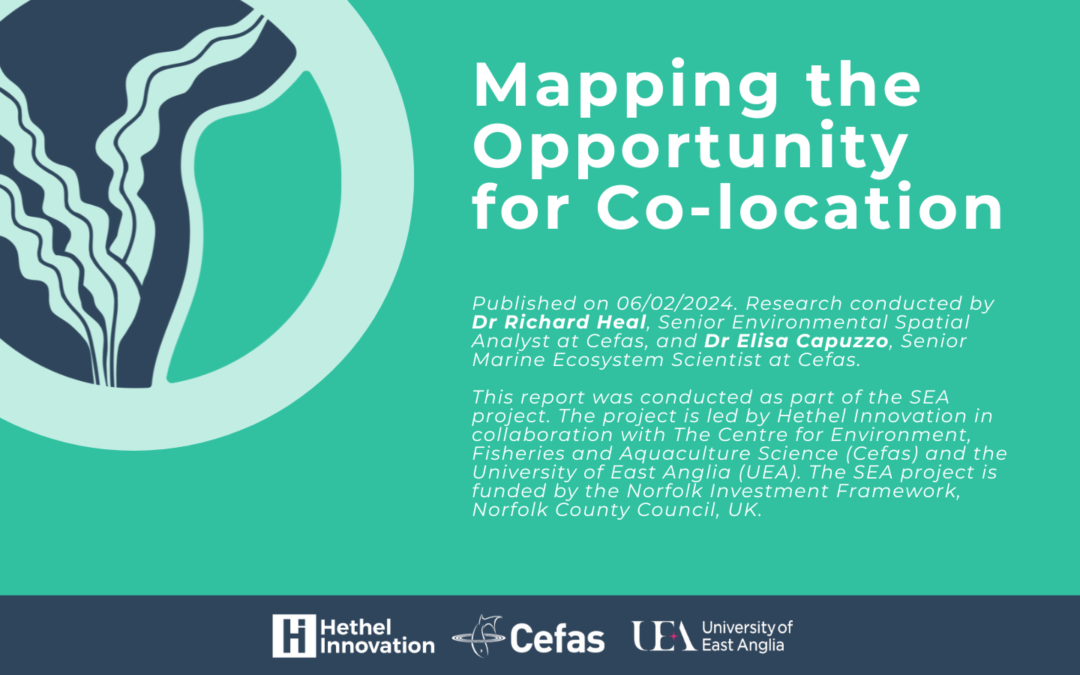Published on 06/02/2024. Research conducted by Dr Richard Heal, Senior Environmental Spatial Analyst at The Centre for Environment, Fisheries and Aquaculture Science, and Dr Elisa Capuzzo, Senior Marine Ecosystem Scientist at The Centre for Environment, Fisheries and Aquaculture Science.
This report was conducted as part of the SEA project. The project is led by Hethel Innovation in collaboration with The Centre for Environment, Fisheries and Aquaculture Science (Cefas) and the University of East Anglia (UEA). The SEA project is funded by the Norfolk Investment Framework, Norfolk County Council, UK.
Norfolk’s Co-location Opportunity
Research has been undertaken to explore the opportunities for seaweed co-location off the Norfolk coast and represented visually in the maps listed below.
The maps in this report identify the locations of future offshore wind farms and therefore spaces that could be used for co-location projects. To take this research further, conversations will need to be had with offshore wind farm providers to define future projects. Funding for a demonstrator project could be looked into.
Key findings
Area of interest
The study area was the marine space out to the limit of the UK Economic Exclusion Zone and incorporated operational and potential offshore wind farms (OWF) at the northerly and southerly extents.
Potential for seaweed aquaculture
The suitability analysis suggests that there were large areas that have the potential for farming brown seaweed such as kelp or red seaweed such as dulse; this included large areas with colocation potential in operational and possible future OWF sites.
Water temperature and crop cycles
The analysis identified that the maximum sea surface temperature was a significant constraining environmental variable for seaweed growth in the months of July, August and September as it exceeded the 17°C threshold. Therefore, harvest of the seaweed crop by June (at the latest) would be advisable.
Limitations
The mapping approach serves as a guide to identify potential areas for further exploration. By covering a large area, the resolution of the spatial data was around 15km2 and used data from different sources including modelled and remote sensing data. The study identified a data gap for high resolution in situ data for the environmental parameters used, particularly water motion (current speed and wave height) and dissolved inorganic nutrient concentration.
Other spatial considerations
A large study area was used and therefore for identified areas of potential seaweed aquaculture other factors such as the distance to port, on shore facilities, access to vessel etc. need to be considered in conjunction with the farming method used.
1. SEA Study Area Map – a map of the study area including the operational and consented Offshore Wind Farms and the Norfolk Seaweed licence area.
2. Annual Seaweed Suitability Map – showing the environmental suitability of seaweed aquaculture using an annual cycle of environmental variables.
3. June Crop Seaweed Suitability Map – showing the environmental suitability of seaweed aquaculture assuming June harvest and October sowing.
4. Annual Seaweed Co-location Map – showing the potential seaweed co-location of Offshore Wind Farms and suitable areas for seaweed aquaculture assuming an annual cycle. This is the Annual Seaweed Suitability Map (Map 2) that is clipped to the operational and consented Offshore Wind Farm areas.
5. June Crop Seaweed Co-location Map – showing the potential co-location of Offshore Wind Farms and suitable areas for seaweed aquaculture assuming June harvest and October sowing. This is the June Crop Seaweed Suitability Map (Map 3) that is clipped to the operational and consented Offshore Wind Farm areas.
6. SEA Project Layered Map – a layered map with all spatial data for the SEA Project study area. To use this layered pdf it must be opened in software that handles layering (e.g. Adobe Acrobat Reader):
- Norfolk Seaweed farm licence area
- OWF in the study area and also as a background layer outside of the study area
- Marine protected areas within the study area
- Other marine uses
- Transportation route
- Historic wrecks
- Shore based recreational angling
- Military range at Holbeach
- Transportation route
- Environmental suitability of seaweed aquaculture (all 4 species present separately):
- Complete suitability assessment across the whole study area for an annual cycle and for June Harvest and October sowing
- Suitability assessment across the OWF sites (operation and consented are separate) for an annual cycle and for June Harvest and October sowing
- Complete suitability assessment across the whole study area but with areas that already have marine use (operational OWF sites & cables, wrecks, transportation & military range) removed for an annual cycle and for June Harvest and October sowing
- Complete suitability assessment across the whole study area for an annual cycle and for June Harvest and October sowing
- Territorial limits for 6nm, 12nm and the UK EEZ
This work has been possible thanks to the Norfolk Investment Framework, Norfolk County Council.


